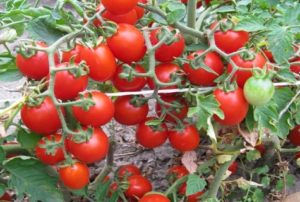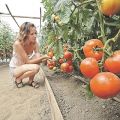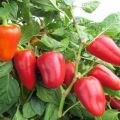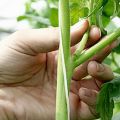Characteristics and description of the Moskvich tomato variety, its yield
For growing in the open field, the Moskvich tomato was created and registered in 1976, which is resistant to low temperatures and a number of diseases of nightshade crops. A short plant with a compact root system is successfully grown in small garden areas, balconies and loggias.
All you need to know about Moskvich tomatoes
When carrying out breeding work, special attention was paid to the resistance of the variety to temperature changes and ripening times. It is these factors that are important for a heat-loving culture, which is not well suited for growing in the conditions of risky Russian agriculture. As a result, the Moskvich variety was highly appreciated and was recommended for use in the Volga, Central regions and horticultural zones of the Urals, Siberia and the Far East. Any characteristic and description of the Moskvich tomato variety demonstrate the success of Russian breeders who have managed to select and consolidate the most important qualities.
Description and main characteristics
The tomato is easy to care for, good yield, high taste and marketability of the fruit.
- A shrub about 40 cm high belongs to the category of determinant, standard plants. A short, strong, erect stem is able to do without a garter to a support.
- Leaves and ovaries are located more compactly, which, with a small size, provides a good yield, up to 4.5 kg per square meter of planting.
- A limited number of stepchildren, an average leaf size, a small green mass do not take away the strength and time of the plant in a limited warm period.
- The root system is located in the surface layers of the soil, ensuring rapid establishment and maximum absorption of nutrients and moisture.
- Growth is limited to 5-7 brushes. Inflorescences begin to form from the 6-8 leaf level. Ripening of tomatoes on a brush occurs together, almost simultaneously.
- "Moskvich" is an early ripening variety, which takes 90-110 days from germination to reaching technical maturity.
- The variety is resistant to late blight, fusarium, a number of fungal diseases, and verticellosis wilt. This is facilitated by varietal characteristics and a short growing season.
Timing often depends on care, adherence to agrotechnical rules, the choice of place and methods of preparing seedlings.

Taste indicators and purpose of fruits
The fruit is smooth, round, deep red, with slight ribbing at the base. Weight ranges from 55 to 75 g. The skin is firm, but not rough.Tomatoes are distinguished by their dense, juicy pulp. The taste of tomatoes grown in the open field is richly sweet, good and excellent according to the tasters.
Moskvich tomatoes are used for various kinds of harvesting and fresh consumption. Their small size and dense texture make them most suitable for pickling and pickling. They are also used for preparing tomato puree, salads, and decorating dishes. The fruits showed themselves well during transportation and storage. Therefore, not only gardeners are interested in them. Farmers plant low-maintenance plants for commercial purposes.
Agricultural technology and care
Plants with a standard type of bush and restrictions on the number of clusters have several advantages over traditional tomatoes.

Growing seedlings and planting in the ground
To obtain a guaranteed harvest, tomatoes are grown by seedlings:
- sowing seeds for seedlings is carried out in the last decade of March, early April;
- in the phase of 1-2 leaves, the plant can be planted in small, personal cups;
- transplanting into the ground traditionally takes place in the second half of May;
- it is advisable to choose a sunny place for planting, protected from the wind;
- the distance between the bushes is 30-40 cm and the row spacing is 60 cm.
According to some gardeners, 6 to 8 plants can be placed per square meter.
Rules for caring for tomatoes in the open field
"Moskvich", like all low-growing varieties, does not require regular removal of stepchildren, formation of a bush, or a garter. Leaving is minimal, but still necessary:
- at the initial stage, the plants are covered with a film until the danger of sub-zero temperatures has passed;
- like all tomatoes, the variety is responsive to a balanced soil composition;
- watering the plant loves moderate, but regular;
- it should be fertilized with complex fertilizers every three weeks before the fruits appear;
- subject to the rules, fruit ripening lasts from early July to late August.
Nevertheless, the area should be kept free from weeds, after watering, loosen the soil. Anyone who has planted tomatoes understands that these simple steps can help prevent root rot and the spread of pests.
Over the years, the Moskvich variety has become well established in garden and summer cottages. Its unpretentiousness, resistance to the vagaries of the weather and common diseases are an indisputable advantage in comparison with other, more spectacular varieties of tomatoes.









